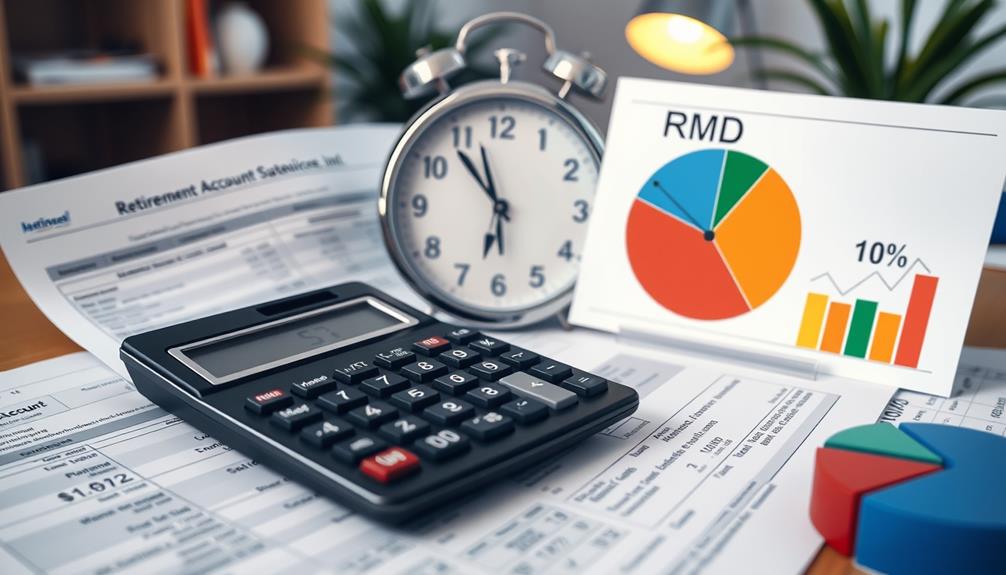To avoid the retirement tax trap with Required Minimum Distributions (RMDs), you need to understand their rules. Starting at age 73, you must withdraw a specific amount from your traditional IRA or 401(k), failing which you'll face a hefty 50% penalty. Delaying these withdrawals can skyrocket your tax burden, increasing taxable income and potentially affecting Medicare premiums. Consider strategies like early withdrawals or Roth IRA conversions to minimize future RMDs. Also, using Qualified Charitable Distributions can meet RMDs while benefiting charities tax-free. Keep reading to uncover strategies that can truly optimize your retirement income and lessen tax exposure.
Key Takeaways
- Start taking RMDs at age 73 to avoid a 50% penalty on missed withdrawals.
- Consider early withdrawals in lower tax brackets to reduce future RMD amounts.
- Convert traditional IRAs to Roth IRAs to eliminate future RMDs and enjoy tax-free withdrawals.
- Utilize Qualified Charitable Distributions (QCDs) to satisfy RMDs while donating to charity, avoiding increased taxable income.
- Seek professional guidance to optimize withdrawal strategies and navigate tax implications effectively.
Understanding Required Minimum Distributions

Understanding Required Minimum Distributions (RMDs) is essential for anyone with a traditional IRA or 401(k). RMDs are mandatory withdrawals that kick in when you turn 73, with your first RMD due by April 1 of the following year.
It's important to grasp how these withdrawals are calculated: you take your account balance as of December 31 and divide it by a life expectancy factor that decreases with age. This means your RMDs will likely increase over time, potentially pushing you into a higher tax bracket.
Additionally, having a solid personal budget can help you manage these distributions effectively and plan for taxes.
Planning your RMDs carefully is crucial, as failing to withdraw the correct amount can incur a steep penalty of 50% on what you should've taken out. This can greatly impact your retirement income and overall financial situation.
If you're looking to minimize tax implications, consider strategies like converting some of your traditional IRA funds to a Roth IRA, which is exempt from RMDs during your lifetime. Consulting a financial advisor can help you develop effective withdrawal strategies, ensuring you navigate the complexities of RMDs without unnecessary tax burdens.
Consequences of Delaying Withdrawals

Delaying your Required Minimum Distributions can lead to hefty tax penalties, including a staggering 50% on the amounts you should've withdrawn.
This delay might push you into a higher tax bracket later, increasing your overall tax burden.
Additionally, leaving too much in tax-deferred accounts can have a negative impact on your heirs, reducing the value of what they inherit.
It's essential to understand tax implications and consider strategies like risk management strategies for Bitcoin IRAs to optimize your retirement savings.
Tax Penalties Accumulate Rapidly
Failing to take your Required Minimum Distributions (RMDs) on time can lead to staggering financial consequences. If you miss a withdrawal, you'll face a hefty 50% penalty on the amount you should've taken out. This isn't just a one-time issue; delaying RMDs can snowball into larger taxable distributions later, potentially pushing you into higher income tax brackets.
Here's a quick look at the implications of delaying RMDs:
| Implication | Details |
|---|---|
| Tax Penalty | 50% on missed RMD withdrawal |
| Larger Future RMDs | Accumulated funds lead to bigger withdrawals |
| Increased Tax Burden | Higher withdrawals can inflate your tax bill |
| Medicare Premiums | Higher reported income can raise costs |
| Impact on Heirs | Larger RMDs affect your beneficiaries' taxes |
You can delay your first RMD until April 1 of the year after you turn 73, but subsequent withdrawals must be made by December 31. Working with a financial planner can help you navigate these rules and avoid unnecessary tax penalties that could hinder your retirement savings.
Higher Future Tax Bracket
Missing your Required Minimum Distributions (RMDs) can lead to immediate penalties, but the long-term consequences might be even more significant. Delaying withdrawals from your tax-deferred accounts can result in larger RMDs that push you into higher tax brackets as your taxable income increases. This is particularly relevant for retirees considering options like a Gold IRA, which may offer a hedge against inflation and potential tax advantages Noble Gold's precious metal investments.
When you finally take these larger withdrawals, you could find yourself facing a substantial tax liability, especially if tax rates rise after 2025.
As your RMDs grow with age, the impact on your finances becomes even more pronounced. Higher RMDs not only elevate your taxable income but can also trigger increased Medicare premiums and taxes on your Social Security benefits.
This compounded tax burden makes it essential to plan ahead. Financial advisors often recommend discussing your withdrawal strategy early to avoid the pitfalls of delayed withdrawals.
Impact on Heirs' Taxes
When you postpone taking your Required Minimum Distributions (RMDs), you not only face potential penalties but also set the stage for increased tax liabilities that can affect your heirs. Delaying withdrawals from traditional IRAs and 401(k)s can result in larger RMDs later, pushing your taxable income—and that of your heirs—higher.
Here's a quick look at the consequences:
| Impact | Details |
|---|---|
| Larger RMDs | Increased taxable income for you and your heirs. |
| Heirs' Tax Rates | Inherited assets must be withdrawn within 10 years. |
| Potential Penalties | 50% penalty on missed RMDs reduces your heirs' inheritance. |
Not only does accumulating funds in tax-deferred accounts elevate the tax burden for your heirs, but it can also lead to higher overall taxes on their inheritance. By making pre-death withdrawals, you could provide a step-up in basis for your heirs, allowing for significant tax savings if investments appreciate. Prioritizing timely distributions can safeguard your heirs' financial future and minimize their tax liabilities.
Calculating Your RMD

Calculating your Required Minimum Distribution (RMD) is essential to guarantee compliance with IRS regulations and avoid hefty penalties. RMDs must begin by April 1 of the year following your 73rd birthday for traditional IRAs and 401(k)s.
Additionally, if you have a Gold IRA, it's important to take into account how your investments in physical gold may affect your overall retirement planning and tax strategy, as they can provide different advantages compared to traditional assets Gold IRAs offer tax advantages.
To calculate your RMD, divide your account balance as of December 31 of the previous year by a life expectancy factor determined by IRS tables. This factor decreases as you age.
For instance, if you're 73 years old with a $1 million IRA balance, you'd use a life expectancy factor of 27.4, resulting in an RMD of about $36,500. If you have multiple IRAs, you can aggregate your RMDs for those accounts; however, 401(k) plans require separate calculations.
It's vital to understand that failing to withdraw the required amount incurs a severe penalty of 50% on the amount not taken. This highlights the importance of accurately calculating your required minimum distributions and making timely withdrawals.
Strategies to Reduce RMDs

To effectively reduce your Required Minimum Distributions (RMDs), consider making early withdrawals from your retirement accounts.
This strategy lowers your account balance over time, which in turn decreases future RMDs.
Additionally, converting your traditional IRA to a Roth IRA can help eliminate RMDs altogether, allowing you to enjoy tax-free withdrawals down the line.
Furthermore, exploring a Gold IRA could also provide an effective way to diversify your retirement portfolio and protect against inflation, potentially enhancing your long-term financial security.
Early Withdrawals Benefits
As you approach retirement, considering early withdrawals from your retirement accounts can be a smart move to manage your future Required Minimum Distributions (RMDs). Once you hit age 59½, you can make early withdrawals without tax penalties. By strategically taking money out while you're still in a lower tax bracket, you can effectively minimize taxes owed in retirement.
This approach can also allow you to diversify your retirement portfolio, possibly including investments like a Gold IRA, which serves as a hedge against inflation and economic uncertainty diversification of retirement portfolio.
Taking larger early withdrawals can notably reduce your account balance, meaning lower RMD amounts later on. This strategy not only helps you control your taxable income, but it also prevents you from being pushed into higher tax brackets when RMDs kick in.
However, it's vital to plan these early withdrawals carefully. You want to guarantee they don't negatively impact your long-term retirement savings and financial stability.
Balancing your withdrawals now can set you up for a more manageable tax situation down the line. By utilizing early withdrawals as a strategy, you gain better control over your finances, setting the stage for a more comfortable retirement.
Roth IRA Conversions
Utilizing Roth IRA conversions can be an effective strategy to further manage your retirement finances and reduce Required Minimum Distributions (RMDs). When you convert funds from traditional IRAs into Roth IRAs, future withdrawals become tax-free and aren't subject to RMDs, giving you greater control over your taxable income in retirement.
Additionally, this strategy can serve as a form of diversification, similar to gold investments, which also aim to protect against market volatility and inflation risks gold investment strategies.
While you'll need to pay taxes on the converted amount in the year of the transfer, timing this conversion during lower income years can help minimize your tax liability. After a five-year holding period, you can withdraw funds from your Roth IRA tax-free, enhancing your financial flexibility.
Additionally, by implementing Roth conversions, you can actively reduce the balance of your traditional IRAs, which leads to lower RMDs in subsequent years. This proactive approach can greatly lighten your tax burden later in retirement.
It's wise to consult with a financial advisor to evaluate the long-term benefits and potential tax implications of executing Roth IRA conversions based on your individual financial circumstances.
The Role of Roth Conversions

Roth conversions serve as a strategic option for many individuals looking to optimize their retirement savings. By transferring funds from traditional IRAs to Roth IRAs, you incur tax liability in the conversion year, but you eliminate future Required Minimum Distributions (RMDs) from those funds.
This can be particularly advantageous as you work towards your retirement goals, especially when considering the importance of keyword optimization in guaranteeing that your financial strategies align with tax efficiency.
Here are three key benefits of Roth conversions:
- Tax-Free Growth: Funds in a Roth IRA grow tax-free and can be withdrawn tax-free after a five-year waiting period.
- Lower Tax Rate Opportunity: By converting during years of lower income, you might pay a lower tax rate than you'd in future higher brackets.
- Locking in Current Rates: If you expect your tax rates to rise in retirement, Roth conversions allow you to lock in current rates on your converted amounts.
Before proceeding, it's wise to consult a financial advisor to assess the conversion's tax implications.
They can help guarantee that your Roth conversion aligns with your overall retirement strategy and minimizes your tax liability while maximizing your tax-free income potential.
Utilizing Qualified Charitable Distributions

For retirees aged 70½ and older, Qualified Charitable Distributions (QCDs) present a valuable opportunity to meet Required Minimum Distributions (RMDs) while supporting charitable causes.
By donating up to $100,000 annually directly from your IRA to qualifying charities, you can satisfy your RMD without increasing your taxable income. This is particularly advantageous for high-income retirees, as using QCDs can effectively lower your adjusted gross income, helping you avoid additional taxes on Social Security benefits and Medicare premiums.
Additionally, top-rated payment solutions for non-profits can enhance the donation process, guaranteeing that contributions are efficiently processed and tracked.
To utilize QCDs, confirm your donation is made directly from your IRA to the charity, and verify that the charity meets IRS guidelines, as not all organizations qualify.
Proper documentation is vital; you must report the distribution accurately on your tax return to confirm the donation's tax-exempt status. Failing to follow these rules could lead to a 50% penalty for not taking your RMDs.
Importance of Professional Guidance

Maneuvering the complexities of Required Minimum Distributions (RMDs) can be intimidating, especially when the stakes involve potential penalties and tax liabilities.
Seeking professional guidance from a financial advisor is vital to navigate these waters effectively. With tailored advice, you can develop strategies that minimize your tax burden and guarantee compliance with IRS regulations. Additionally, understanding best ways to earn money online can provide supplementary income that may influence your withdrawal strategies.
Here are three significant reasons to consult a professional:
- Avoid Costly Penalties: The penalties for under-withdrawing can reach up to 50% of the amount you should've taken. A financial advisor helps you stay compliant.
- Optimize Withdrawal Strategies: Wealth managers can assist in crafting a withdrawal plan that effectively manages taxable income, which is essential for your retirement years.
- Personalized Planning: RMD rules vary based on account types and individual circumstances. A qualified tax advisor will consider your unique financial situation, including the potential conversion of an IRA to a Roth, to provide a thorough strategy.
Engaging with a professional not only aids in avoiding pitfalls but also aligns your financial goals with changing tax laws, guaranteeing a smoother changeover during your retirement years.
Navigating Tax Implications

Maneuvering the tax implications of Required Minimum Distributions (RMDs) is essential for your financial health in retirement. RMDs must begin by age 73, and if you fail to withdraw the required amount, you'll face a hefty 50% penalty on the shortfall.
Calculating your RMDs involves dividing your traditional IRA balance as of December 31 by a life expectancy factor from IRS tables, which can lead to larger amounts over time.
Delaying RMDs might seem tempting, but it can push you into a higher tax bracket later, increasing your taxable income and taxes on Social Security benefits.
To navigate this potential tax trap, consider a strategy that can reduce your taxable income. Making charitable donations directly from your IRA can satisfy your RMD requirement tax-free, allowing you to support causes you care about while lowering your overall tax liability.
Frequently Asked Questions
How to Avoid Paying Taxes on Required Minimum Distribution?
To avoid taxes on required minimum distributions, consider converting traditional IRAs to Roth IRAs, utilizing qualified charitable distributions, and planning early withdrawals. Engaging with a financial advisor can help tailor strategies to your situation.
How Do You Withhold on RMD to Simplify Paying Taxes?
To simplify paying taxes on RMDs, you can elect to withhold a percentage for federal taxes. This helps avoid underpayment penalties and spreads your tax burden, making your tax management more manageable throughout the year.
What Is the Best Way to Take the Required Minimum Distribution?
To take your required minimum distribution effectively, calculate it based on your account balance and IRS life expectancy factors. Consider withdrawing early in the year and explore charitable donations to minimize your tax burden.
What Is the One Word Secret to Lowering the Tax Hit on Your IRA RMDS?
The one word secret to lowering the tax hit on your IRA RMDs is "strategy." By implementing effective withdrawal plans and considering options like Roth conversions or Qualified Charitable Distributions, you can minimize your tax burden efficiently.
Conclusion
Finding your way through required minimum distributions doesn't have to feel like walking a tightrope. By understanding your RMDs and implementing strategies like Roth conversions and charitable distributions, you can sidestep the retirement tax trap. Don't hesitate to seek professional guidance—it's like having a GPS on a winding road. With careful planning, you can secure your retirement and keep more of your hard-earned money. Start taking control today, and enjoy your golden years without the tax worry!










